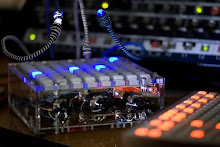Eigenlabs has indeed been busy in the last year and has made great strides in addressing usability concerns as well as simply maturing the product into something fit for a more mainstream player.
I wish I could say that I have matured as a player along with the platform, but I took quite a long hiatus from the instrument after a bit of burnout from being an early adopter. There were a few early design decisions in the software that were a nightmare for usability, most notably, having to control the user interface of EigenD on the computer with the harp itself. Luckily, Eigenlabs listened to users and fixed this issue.
The most significant improvement is the introduction of "Stage" which is a new user interface that exposes all the internal routing and settings of the system as a set of user defined controls that you can tweak on the computer or from your iPhone or iPad remotely. This is a brilliant solution for controlling all the settings that are buried within EigenD. It's quite easy now to create very detailed custom setups for oneself, save these or even share them with other users. You basically choose from a menu of options and are able to create new tabs, and drag and drop controls onto them. This interface and all settings are stored along with your saved EigenD setups and can be recalled at will. This can totally replace the awkward original concept of controlling the computer user interface from the harp.
"Stage" was the feature that brought me back to the Eigenharp and convinced me to reengage. Generally the workflow is to drop instrument plugins (VSTs, AUs) into slots in EigenD, along with the ability to connect via Midi or to use soundfonts for sampled instruments, you then create one or more performance setups while sitting in front of the computer. Once you have a setup, you can divorce yourself from the computer and simply recall the different instruments with the eigenharp itself. Because the stage interface is available on an iPad or iPhone, this can be used on stage for simple tweaks to volume of the mix and other settings you wish to make on the fly.



Another big improvement to EigenD are the configuration grids for connecting the various controls on the harp to parameters of different instruments. One grid allows the linking of eigenharp controls such as strip controllers, breath, key controls to Audio unit and VST parameters. The other grid is dedicated to Midi control.
The Midi settings window is one of the most full featured midi implementations I have ever come across. EigenD can now do very advanced things such as send 14 bit midi control information instead of 7 bit. It can send poly pressure to instruments that support it. But most importantly, it can use multichannel midi to send each key presses data stream on a separate midi channel. This allows for per note control of all the key expression (pitch, yaw, pressure, velocity) available on the harp and it can do this using 14 bit CCs if you wish. Some notable plugins such as Spectrasonics Omnisphere and Trillian, Native Instrument Kontact to name a few, support multichannel setups and can offer great expression with such a setup.


To understand the amazing sensitivity and control that the eigenharp offers, you really need sounds that are designed specifically to take advantage of the additional control aspects the harp can offer.
To demonstrate such a sound, I reconfigured a sound that Edmund Eagan had designed for the Continuum (another interesting and expressive controller) to work with the eigenharp. The sound engine is a KYMA Pacarana and the connection is using a multichannel midi setup such as I mention above. The result is a sound that would be impossible to control in such a way on a keyboard.
The last point that I wish to mention regarding Eigenlabs is around the original promise from Eigenlabs founder John Lambert to Open Source the EigenD code. I'm happy to say that Open Sourcing did indeed recently happen. There are many benefits to this. Firstly, a development community can form around connections to EigenD as well as the creation of add ons, bug fixes, etc. Secondly, Open Sourcing creates confidence in the personal investment of owning such an instrument. If Eigenlabs went away in the future or dropped support for the original eigenharps, the software would still be able to be built, upgraded and published by the community at large.
Finally, the last gap that has been filled is support for Windows OS and specifically Windows support for the larger Alpha and Tau models. Eigenlabs has just released an early version of 1.4 that brings Windows OS support to these instruments.
Indeed, Eigenlabs has been busy and I for one applaud the great progress. If you've been on the fence about picking one up. The water is now safe to enter.



